Chapter 18.35
RESIDENTIAL MULTIFAMILY – MEDIUM DENSITY (RMM)
Sections:
18.35.020 Permitted principal uses.
18.35.030 Permitted accessory uses.
18.35.070 Maximum building height.
18.35.080 Setbacks and lot coverage.
18.35.100 Accessory building and use regulations.
18.35.110 Screening and landscaping requirements.
18.35.120 Recreation facilities.
18.35.140 Design requirements.
18.35.010 Purpose.
The main intent of the residential multifamily – medium density (RMM) zone is to provide housing opportunities in a variety of forms at urban densities of between 10 and 30 units per gross acre. The zone has been established in those areas of the City which predominantly consist of legal lots of record of one acre or more, thus enabling a variety of housing forms as well as the establishment of amenities and infrastructure necessary to serve the development, as compared to multifamily development on smaller properties that may have diminished opportunity to plan for or to establish comprehensive developments.
By requiring densities of between 10 and 30 units per gross acre, the medium density zone also acts as a transition zone between single-family residential zones and more dense multifamily, mixed use, or commercial zones.
The site and building design guidelines contained in this chapter are intended to provide applicants with a general description of the City’s expectations for design that will create a safe and attractive sense of place for the community and residents. Substantial flexibility is provided in order for applicants to identify creative, site-specific steps to address these issues. (Ord. 2026 § 1 (Exh. 1), 2017)
18.35.020 Permitted principal uses.
Permitted principal uses are as follows:
A. Residential development resulting in densities of between 10 and 30 residential units per gross acre. See FMC 18.35.160 for visual representations of recommended designs;
B. Day care or day nursery;
D. Municipal use;
E. Single-family dwellings existing, or for which building permits were issued, prior to September 4, 2006, and single-family dwellings constructed on parcels created, or approved, between October 23, 1996, and September 4, 2006. (Ord. 2066 § 1 (Exh. 1), 2018; Ord. 2026 § 1 (Exh. 1), 2017)
18.35.030 Permitted accessory uses.
Permitted accessory uses are as follows:
A. Laundry, recreation and other necessary facilities used exclusively by apartment building tenants;
B. Permitted accessory uses in the single-family dwelling zones;
C. Home occupations;
D. A use customarily incidental to the permitted principal use. (Ord. 2066 § 1 (Exh. 1), 2018; Ord. 2026 § 1 (Exh. 1), 2017)
18.35.040 Conditional uses.
A. Conditional uses are as follows:
1. Recreation facility;
2. Church.
a. Pursuant to Chapter 35A.21 RCW, outdoor, temporary encampments for the homeless hosted by religious organizations shall be reviewed as a separate or amended conditional use from the authorizations originally granted to a church, subject to reasonable measures to ensure basic sanitation, life safety, and the minimization of negative public health and/or safety impacts to surrounding uses. See FMC 18.72.140 for specific conditions related to these uses;
3. Grocery store, drugstore, coffee shop, professional office, other retail uses customarily defined as serving the needs of the surrounding residential neighborhood. The aggregate size of all commercial uses shall not exceed 3,000 square feet in gross floor area, unless otherwise authorized through the PUD process;
4. Complete life care retirement community (reviewed as a PUD);
5. Public use;
6. A use similar in nature and effect to a permitted principal use or conditional use. (Ord. 2066 § 1 (Exh. 1), 2018; Ord. 2026 § 1 (Exh. 1), 2017)
18.35.050 Minimum lot size.
Minimum lot size is as follows:
A. Three thousand five hundred square feet for single-family detached residences; for all other uses, minimum lot size shall be based upon the ability of the applicant to demonstrate compliance with all other adopted City regulations while achieving the density range described by this chapter. (Ord. 2026 § 1 (Exh. 1), 2017)
18.35.055 Density.
A. The achieved density of development within the RMM zone shall be between 10 and 30 units per gross acre, based on the entirety of the property to be developed.
B. Exceptions. Flexibility in density allowances may be granted administratively in the following cases. However, flexibility shall not be considered a waiver from density requirements, and the applicant shall be required to obtain densities as close to the range described by this zone as practical.
1. An applicant may be granted relief from achieving the range of densities required by this chapter if they are able to demonstrate that it is not practical to achieve required densities while also satisfying infrastructure and environmental protection requirements. In evaluating these claims, City staff may not consider the cost of compliance as the primary factor in granting flexibility,
but may consider whether the City’s requirements can all be met in a manner that would result in a development that meets the overall design requirements of this chapter.
2. Properties of less than one-half acre in size may be granted relief from achieving the range of densities required by this chapter if they are able to demonstrate that it is not practical to achieve required densities while also satisfying infrastructure and environmental protection requirements.
3. The City may authorize an increase in allowable density for those uses such as complete life care retirement communities that typically include shared living and dining spaces. (Ord. 2026 § 1 (Exh. 1), 2017)
18.35.060 Minimum lot width.
Minimum lot width is as follows:
A. Fifty feet. (Ord. 2026 § 1 (Exh. 1), 2017)
18.35.070 Maximum building height.
Maximum building height is as follows:
A. Fifty feet for those structures set back at least 20 feet from single-family zones.
B. Thirty-five feet for those structures set back less than 20 feet from single-family zones. (Ord. 2026 § 1 (Exh. 1), 2017)
18.35.080 Setbacks and lot coverage.
Setbacks and lot coverage are as follows:
A. Setbacks.
1. Front: 20 feet;
2. Rear: eight feet;
3. Sides: eight feet;
4. Zero-foot side and rear yard setbacks may be allowed in this zone; provided, that:
a. Adjoining lots must also be within the RMM zone;
b. A recorded subdivision and/or a recorded statement of mutual consent between property owners must clearly state that zero-foot side setbacks may be considered;
c. Proof of recorded subdivisions or consent agreements must be provided upon application for development approvals.
B. Lot coverage (maximum): None. (Ord. 2026 § 1 (Exh. 1), 2017)
18.35.090 Parking.
Parking is determined by use. For specific regulations on parking, refer to Chapter 18.76 FMC. (Ord. 2026 § 1 (Exh. 1), 2017)
18.35.100 Accessory building and use regulations.
A. Accessory building and use regulations are as follows: For specific regulations on accessory buildings or uses, refer to FMC 18.72.050.
B. Accessory dwelling units may be allowed within single-family detached subdivisions described in FMC 18.35.020(E), subject to the limitations of Chapter 18.34 FMC.
C. Accessory dwelling units may be incorporated into the design of developments that are subject to this chapter; provided, that the total density of the development does not exceed the maximum density of the zone. (Ord. 2026 § 1 (Exh. 1), 2017)
18.35.110 Screening and landscaping requirements.
Screening and landscaping requirements are as per Chapter 18.74 FMC. However, this chapter seeks to emphasize the use of screening and landscaping as part of overall site and architectural design. Screening and landscaping shall be incorporated with initial site and architectural design concepts to the greatest extent practical. In no case may screening or landscaping be planted within an easement unless when authorized by a City-approved landscaping plan. (Ord. 2026 § 1 (Exh. 1), 2017)
18.35.120 Recreation facilities.
All multifamily developments shall be subject to the provisions of the City’s parks, recreation and trails master plan. (Ord. 2026 § 1 (Exh. 1), 2017)
18.35.130 Design Review Committee established.
Repealed by Ord. 2249. (Ord. 2026 § 1 (Exh. 1), 2017)
18.35.140 Design requirements.
A. Design Process.
1. The City of Ferndale has identified the following prescriptive design methods of residential construction. Unless otherwise noted, each of these methods may be utilized on a variety of housing forms and is not limited to the specific housing form shown.
2. Provided, that the applicant can demonstrate to the satisfaction of the Community Development Director that the basic goals associated with each design have been met, the application may be approved administratively.
3. Should the applicant propose an alternative design, or if either the applicant or the Community Development Director believes that the design does not address the basic goals associated with a specific design, the Design Review Committee established by FMC 18.35.130 shall be convened.
4. When evaluating designs, City staff shall seek to verify that the following goals have been achieved:
a. Overall design and design elements are functional and are of a sufficient size, type and location where they could be reasonably used for their intended purpose.
b. Overall design and design elements contribute to safety, provide recreation opportunities on site or provide reasonable connectivity to public recreation opportunities off site.
c. The development is comprehensively designed in a manner that places landscaping, infrastructure, and buildings in logical and efficient locations.
d. The maintenance of sites and individual units can be accomplished in a cost-effective manner for the reasonable lifespan of the development, which does not substantially increase the cost of living. (Ord. 2026 § 1 (Exh. 1), 2017)
18.35.150 Design intent.
A. The intent of this section is to provide applicants within the RMM zone significant flexibility in design while establishing basic mandatory parameters (or goals) that must be adhered to. The prescriptive designs included in this chapter are intended as reference points, and the City has intentionally avoided establishing design requirements which depend upon a specific number or type of design elements (i.e., minimum or maximum roof pitch angles, maximum facade areas, etc.), in order to ensure that all design elements that are proposed are functional.
B. Compliance with the design requirements described below is mandatory; however, the inclusion of specific design elements may vary from project to project based on the overall design concept proposed by the applicant. Images included in this chapter are intended as examples only, and shall not be interpreted as a design template.
C. In evaluating design compliance, City staff shall consider project narratives and proposed construction documents provided by the applicant which describe in detail the approach the applicant proposes to achieve the standards of this section. In those cases when the applicant believes that it is impossible or impractical to achieve full compliance, the applicant shall be required to demonstrate, in writing, how compliance cannot be achieved and to propose alternatives that meet the purpose and intent statement of this chapter, as well as the housing goals and policies contained in the Housing Element of the Ferndale Comprehensive Plan. As per FMC 18.35.130, a Design Review Committee may be convened to evaluate proposals that deviate from the design requirements of this chapter.
1. In evaluating design compliance, neither the City nor a Design Review Committee shall consider arguments that design features or amenities should be minimized or eliminated in order to achieve required densities.
2. In evaluating design compliance, neither the City nor a Design Review Committee shall consider arguments to reduce essential infrastructure, environmental protection, or parking when the reduction or elimination of such elements could result in increased impacts to public infrastructure or the environment, or when City staff believes that there is a high likelihood that reduction of these elements would shift impacts to other private properties.
D. In general, unusable or artificial design elements such as false windows, false porches, false fronts, and similar approaches intended only to gain compliance with the code should not be utilized. However, nothing in this chapter shall be interpreted to mean that such elements are to be prohibited in all cases. (Ord. 2026 § 1 (Exh. 1), 2017)
18.35.160 Building design.
A. Elements Common to All Designs. Residential structures within the RMM zone shall utilize a variety of design approaches in order to accomplish the following:
1. Incorporate structural design and materials that reduce the overall cost of living through conservation, durability, and/or cost-effective replacement.
2. Establish close engagement with both frontage and interior streets via highly visible front porches, front steps within close proximity of sidewalks, parking and garages within the building envelope or at the rear of the primary building, and prominent street trees along frontage streets.
3. The applicant shall consider incorporating architectural and landscape lighting within the development in order to accentuate architectural features, safety, and a sense of place during evening hours.
4. Nothing in this chapter shall prohibit the development of more than one identical building within the same project. However, the applicant shall incorporate variations to color, materials, entryways, alignment, and/or other methods in order to create variation between structures within the development.
5. In order to minimize the appearance of large structures that overwhelm the streetscape, the applicant shall propose a mix of colors and building materials, shall emphasize entryways and porches at street level, and shall incorporate landscaping into the overall design.
6. The appearance of long exterior balconies or corridors shall be minimized to the greatest extent practical.
B. Traditional Multifamily Design. The traditional multifamily design model applies directly to multifamily developments consisting of between two and eight units per building, and may be from two to four stories in height. The traditional design is typified by peaked or varied roof pitches, porches, balconies, and windows facing the street. As the RMM zone anticipates that multiple buildings will be constructed in one development, a variety of housing design buildings or facade treatments are required.
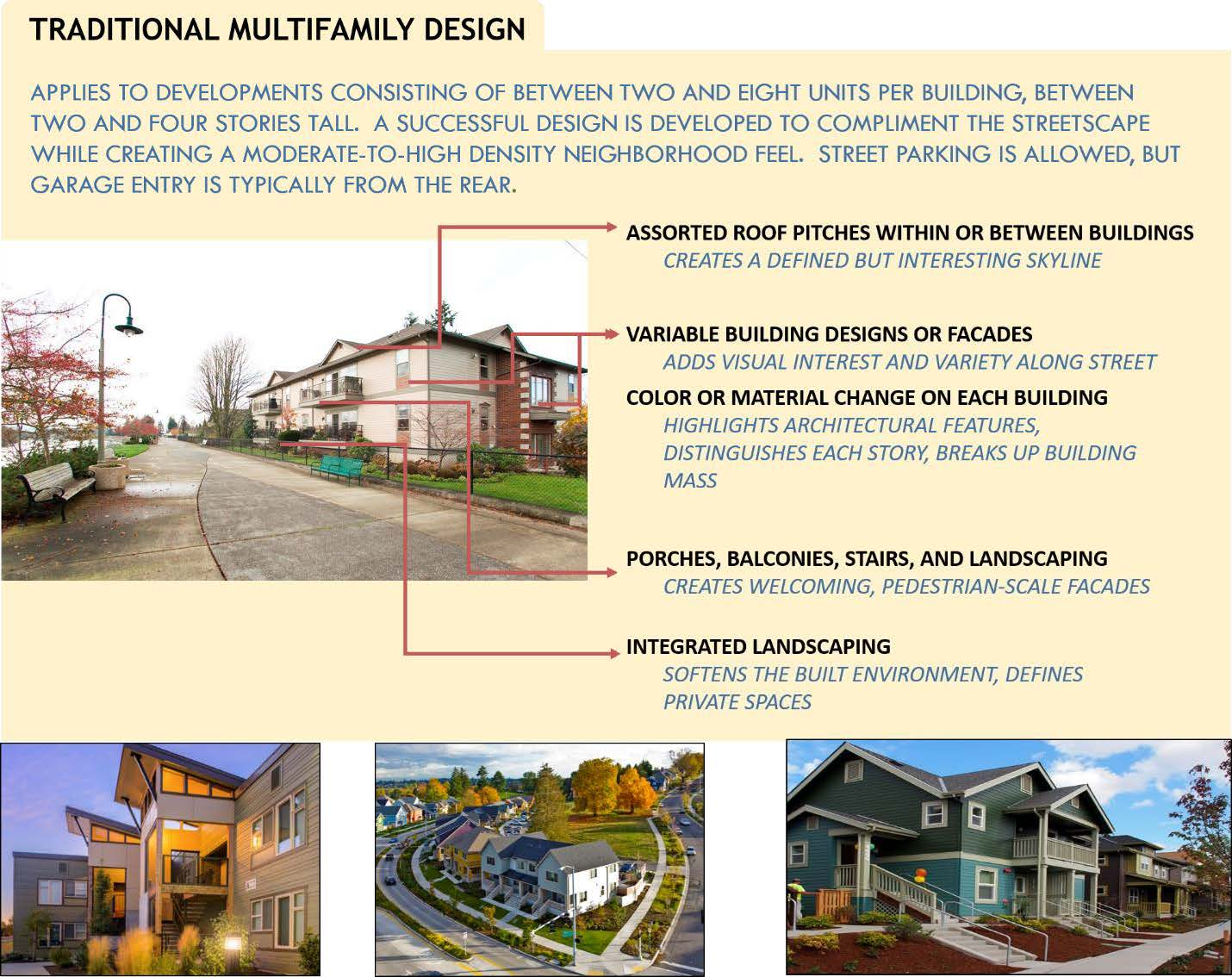
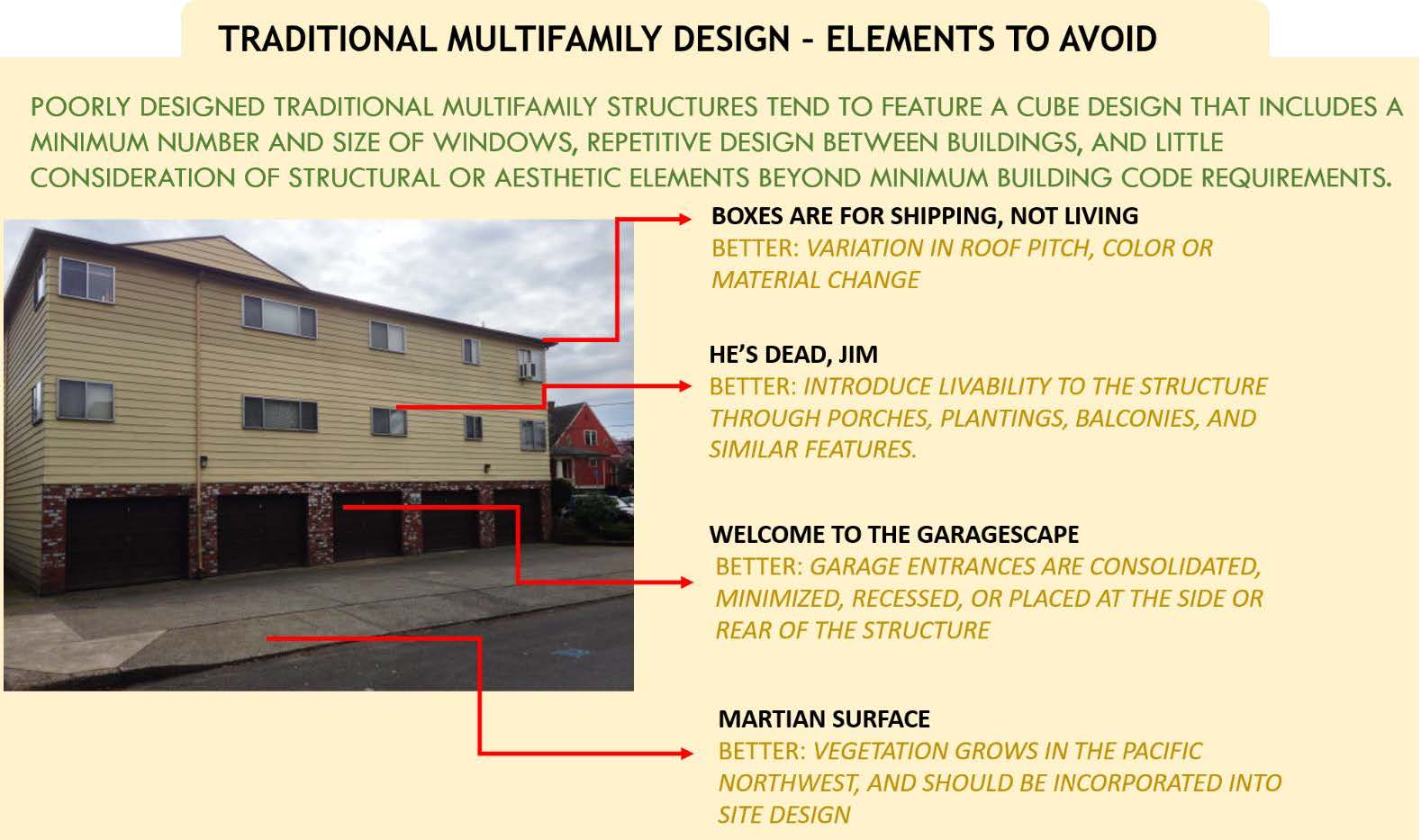
C. Residential Townhouse. The residential townhouse design model applies to both single-family attached and multifamily development, where three or more separate residences sharing common walls are arranged in what is typically a linear fashion along a fronting street. Depending upon the specific development, the individual units may reside on one shared property or may be on separate properties that can be purchased and sold. Townhouses may be designed to reflect traditional single-family elements, to reflect urban “row house” design which emphasizes vertical elements, or may utilize a combination of approaches.
In Ferndale, particular emphasis is placed on external articulation in order to clearly define a separation between dwelling units as well as providing visual interest through color or material changes. A recurring pattern of styles is generally discouraged. Due to the relatively narrow facades that are typical in townhouse design, front-facing garages are also discouraged, or should be minimized.
Townhouse designers are also expected to consider provisions for usable open space associated with each unit, or shared between units.
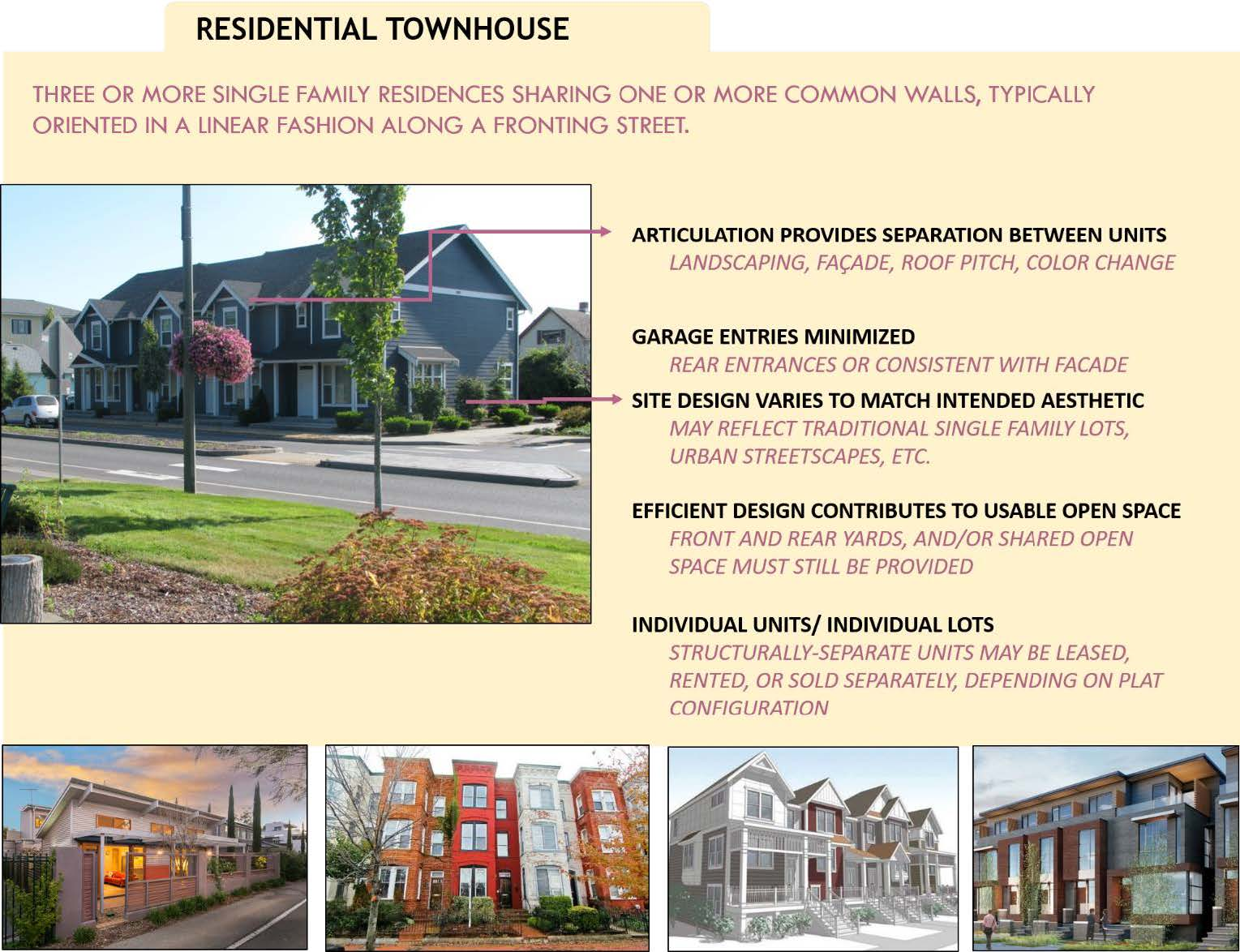

D. Mid-Rise Multifamily Design. Mid-rise multifamily design consists of five or more units per building, generally ranging from three to five stories in height, and sometimes including a portion of or all required parking within the footprint of the structure. Shared entryways to the building are typically provided, and are given prominent emphasis.
The relative size and massing of mid-rise multifamily developments are broken up through articulation, balconies, large windows, and color or material changes. Exterior walkways along the first floor are generally discouraged in order to avoid styles commonly associated with motel architecture.
Landscaping appropriate to the size and scale of the building is required, and landscaping such as living walls, trellises, and similar may be utilized to emphasize and soften vertical elements. Due to the nature of the development, which tends to consolidate residential units into one or more vertically-oriented buildings with a limited number of entries, designers shall provide landscaping necessary to minimize the view of large parking lots from the street or adjacent properties.
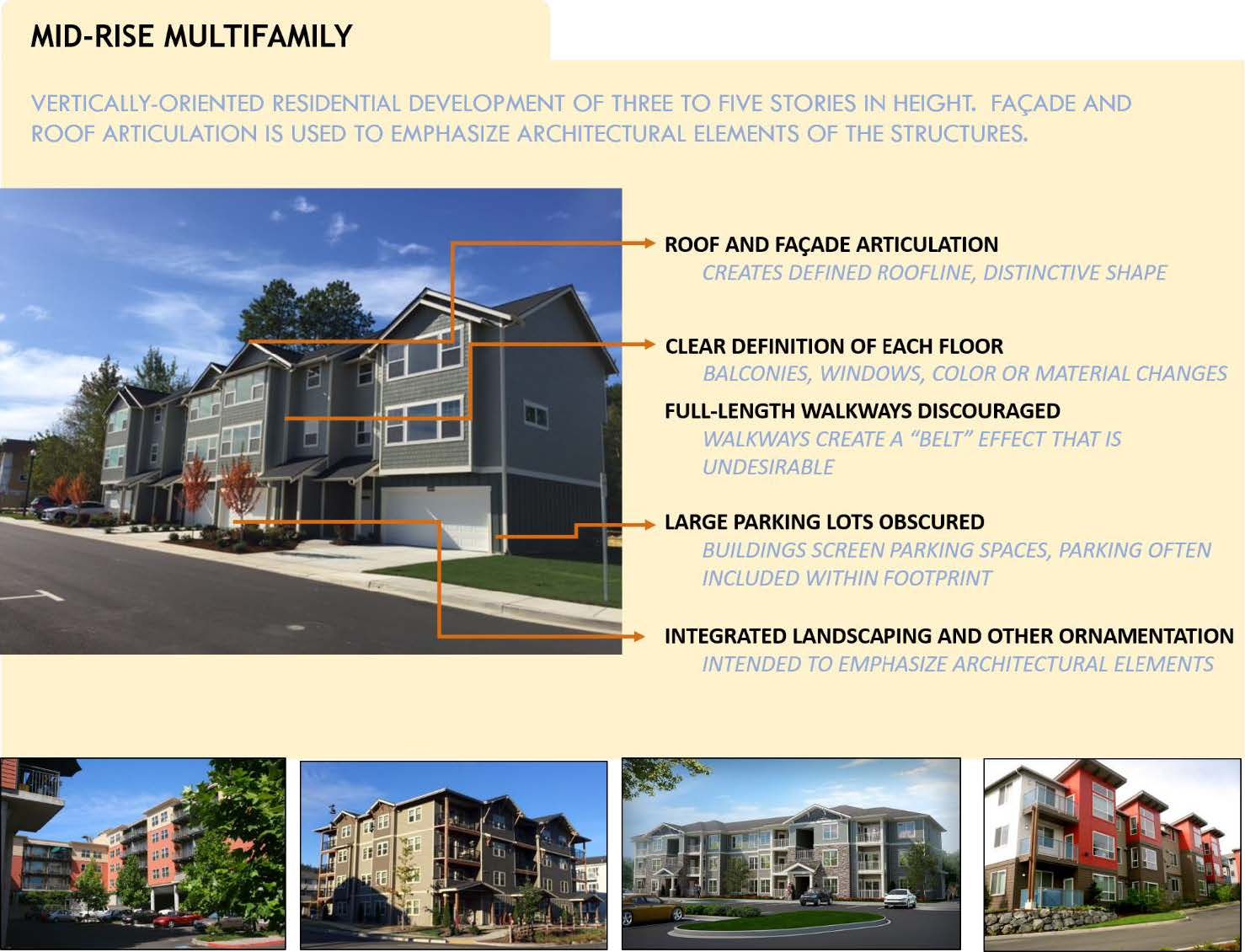
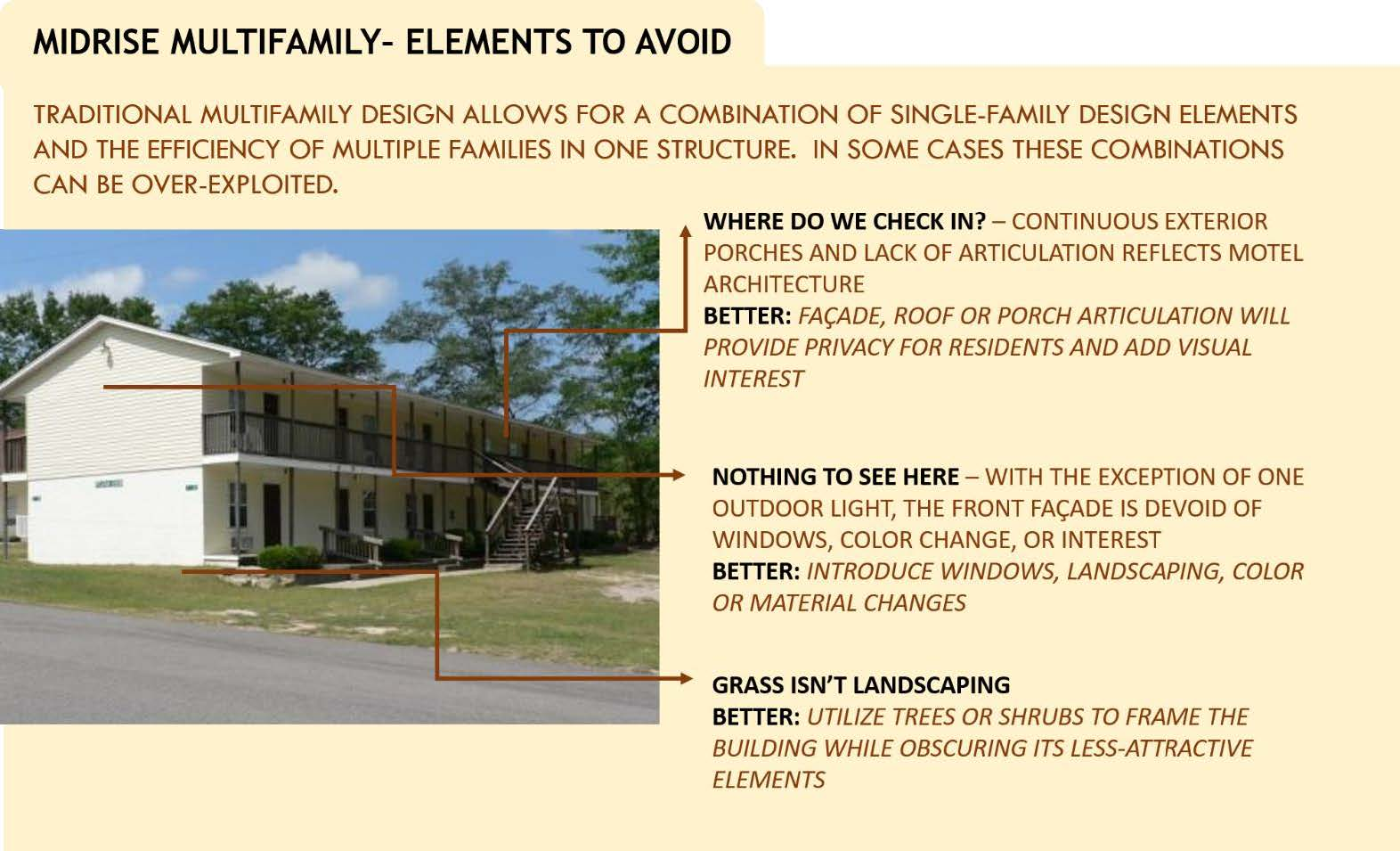
E. High Density Single-Family. The high density single-family design approach meets the density requirements of other residential uses in the zone while preserving the independence gained from detached or attached single-family housing.
In general, individual residential units are relatively small and rely on shared open space rather than large front, side, or rear yards. Shared infrastructure such as driveways or parking lots further reduces the overall footprint of high density single-family design. The primary objective of this design approach is not to promote small or “tiny” houses, although such developments may be permitted when integrated with other housing designs. The high density single-family design departs from townhouse design by allowing nonlinear attached development.
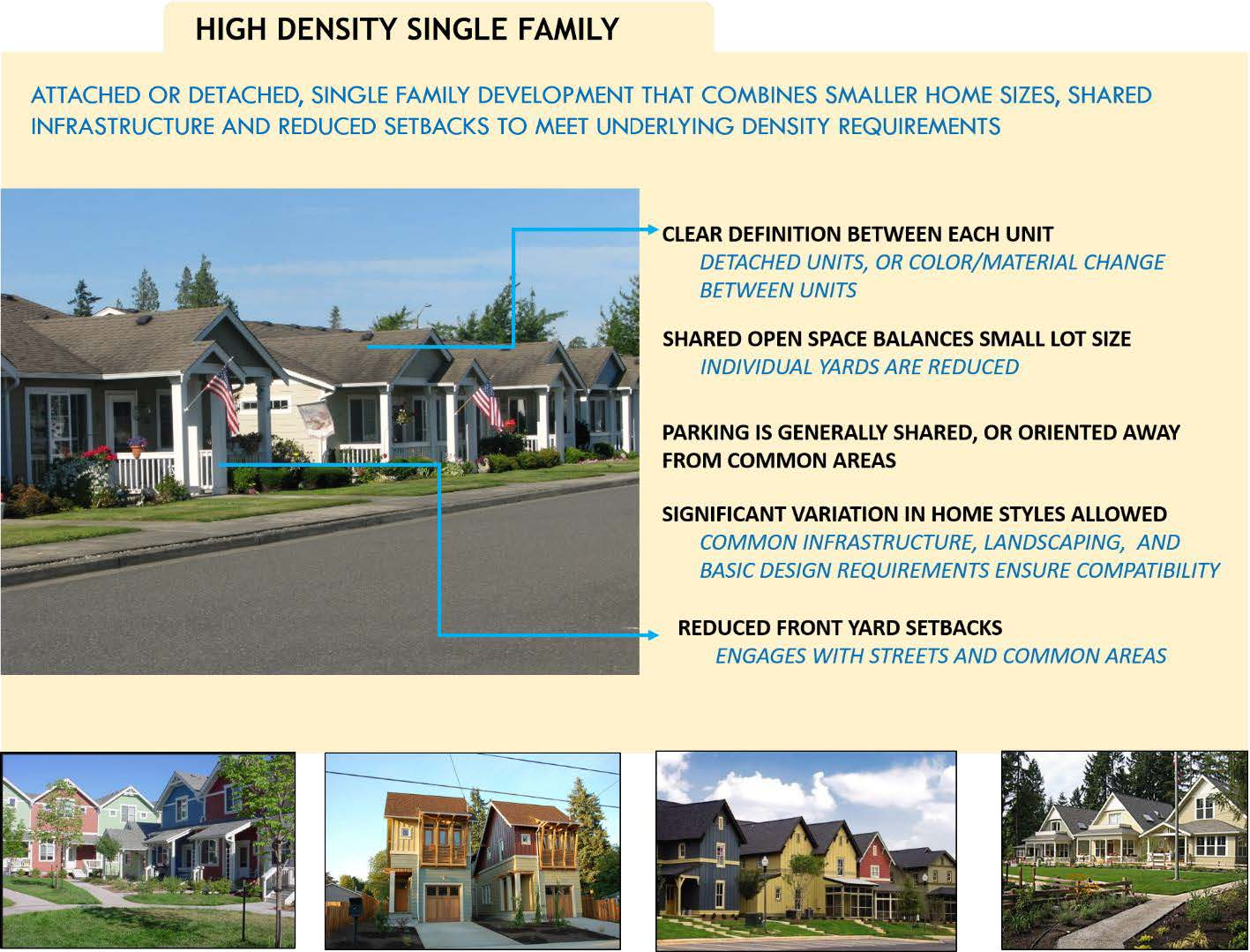
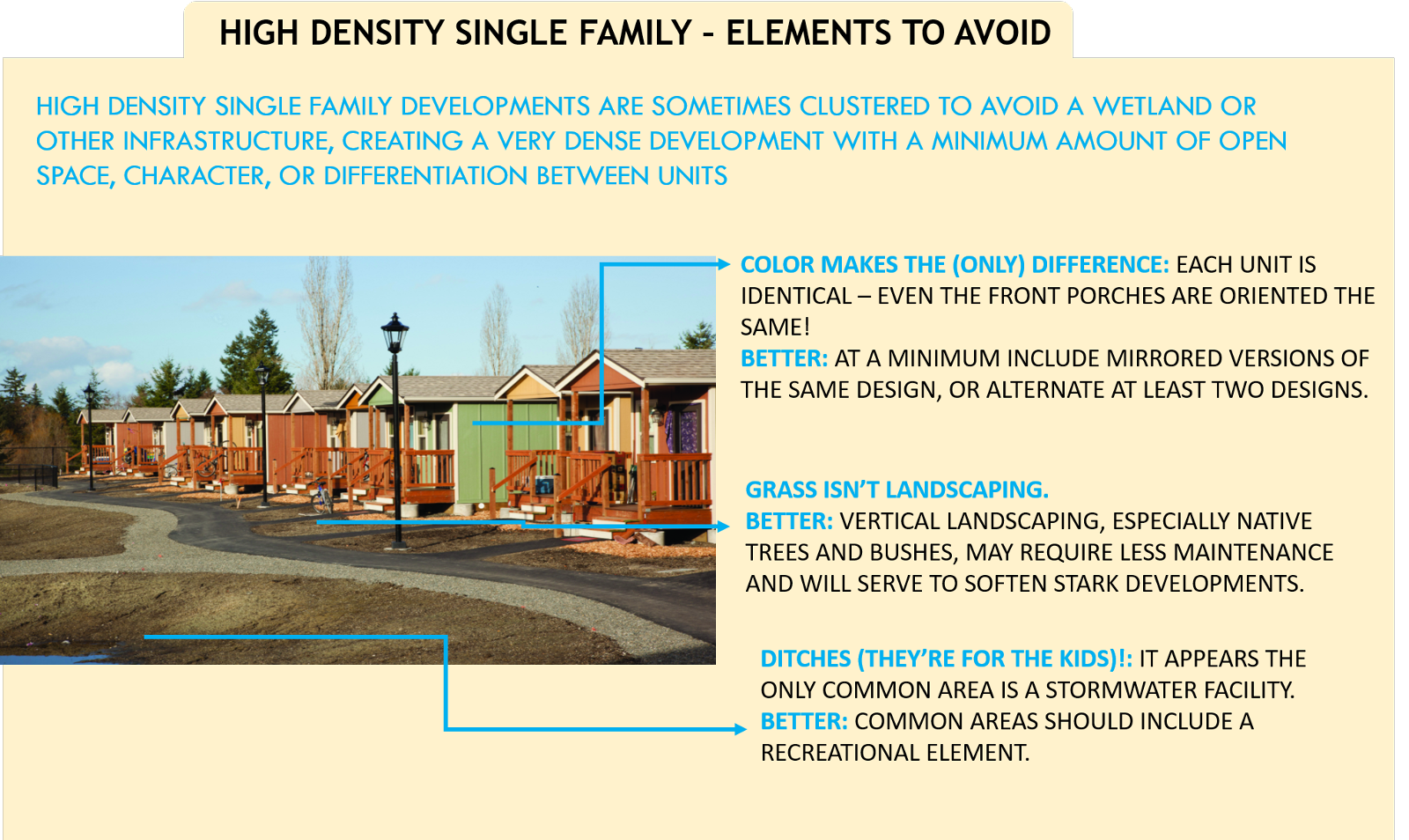
F. High-Efficiency Multifamily. The high-efficiency multifamily approach is very similar to the mid-rise multifamily approach in terms of design styles and the overall appearance of buildings and site design. The high-efficiency design approach results from the fact that the majority of units are designed for one- or two-person occupancy, thus resulting in potential infrastructure reductions. However, while the per-unit costs of infrastructure and permitting may be reduced, no reduction in design or material quality will be considered.
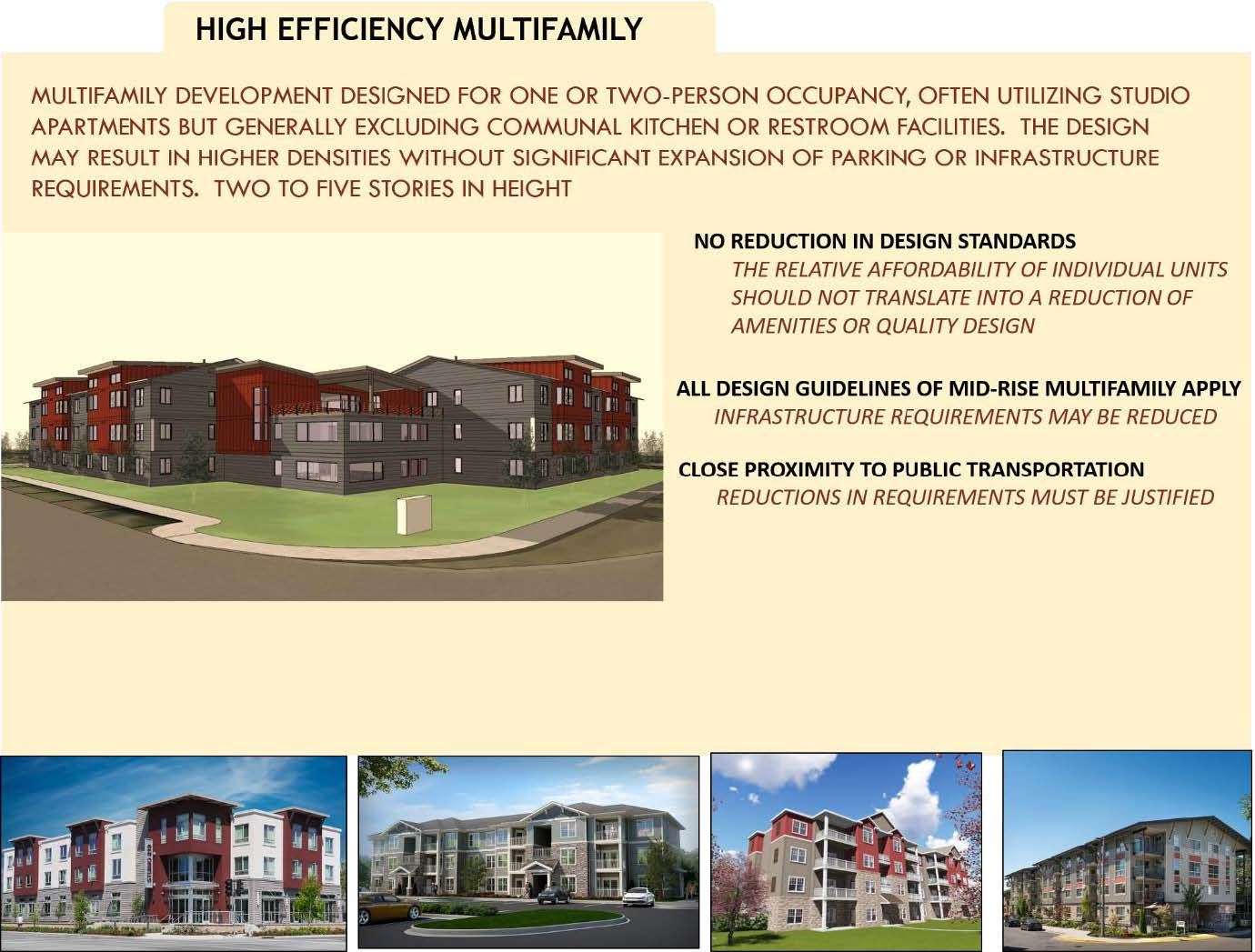
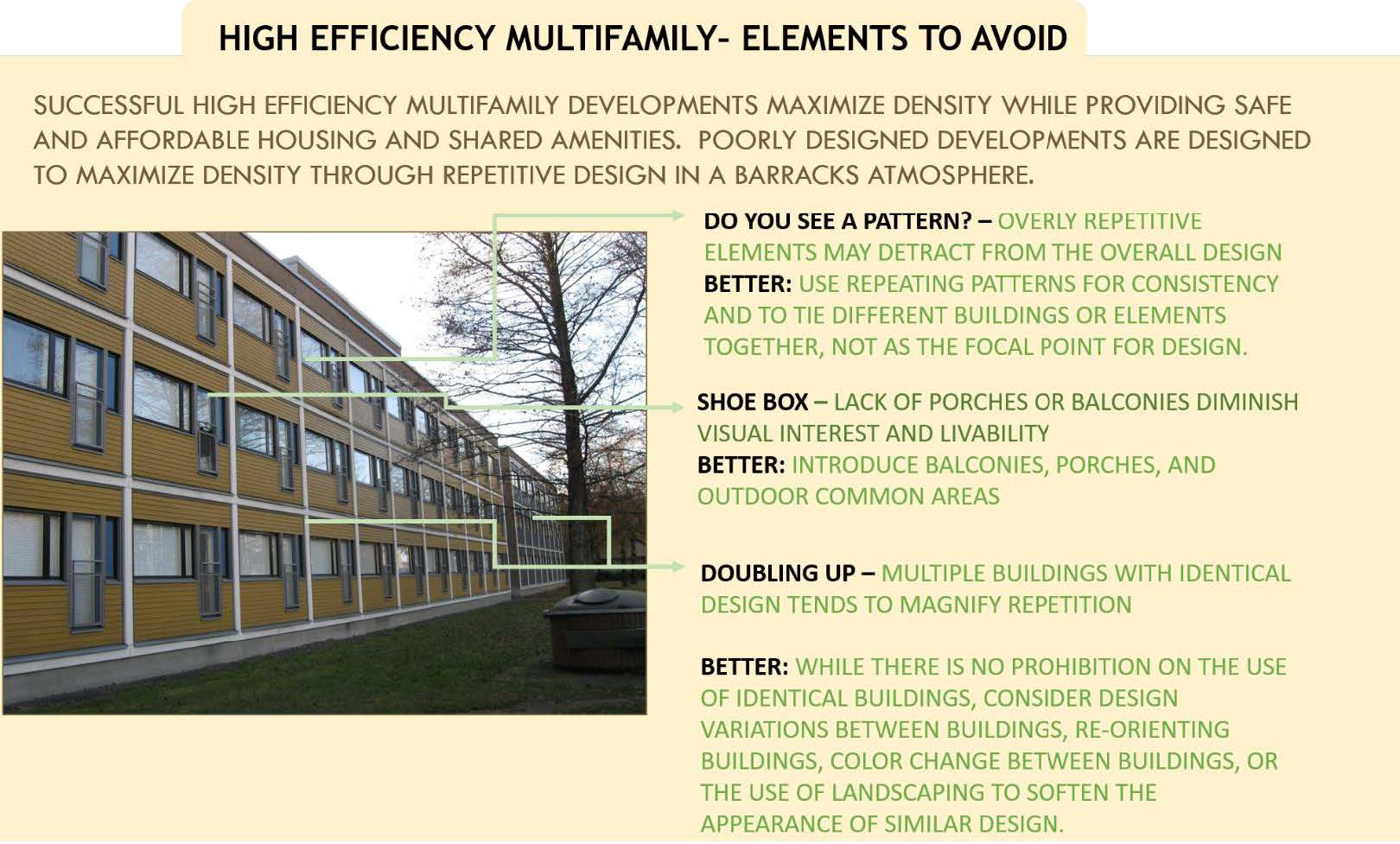
(Ord. 2026 § 1 (Exh. 1), 2017)
18.35.170 Site design.
A. Developments within the RMM zone will generally be created from parcels that are large enough to accommodate required infrastructure, fronting and/or interior streets, landscaping, open spaces, and one or more residential structures. Substantial flexibility in setbacks, lot sizes, and lot coverage is provided in order for the applicant to comprehensively design a development which meets the following requirements:
B. Required parking spaces for residents must be distributed throughout the development in order to minimize the appearance of consolidated parking lots and to increase convenience and safety for residents.
C. Building footprints and/or individual building lots, together with identified amenities and open spaces, shall be identified in primary approval documents, and efforts shall be made to ensure all residents are within close proximity to these shared amenities.
D. Residential multifamily developments must be located in close proximity to public parks, trails, or other open space so as to provide active recreation opportunities to youth who may reside in the development.
1. The applicant shall consider the inclusion of amenities such as sport courts, community gardens, and open spaces.
2. When a development is not within one-quarter mile of a public trail or park, the development shall be required to establish at least one-quarter acre of active open space.
E. Public streets in developments within the RMM zone shall comply with City Development Standards for construction and dimensional requirements, unless variances are granted for additional flexibility. In some cases, private streets that serve only the development may be established, and may be provided greater variability, provided that easements for City utilities and emergency access provisions have been incorporated.

(Ord. 2026 § 1 (Exh. 1), 2017)
18.35.180 Landscaping.
A. The City of Ferndale recognizes that the establishment and ongoing maintenance of mature landscaping that acts as a complement to the built environment will significantly enhance the livability of a development, as well as its general appearance. All developments approved in compliance with this zone shall be required to establish landscaping throughout the development. All applicants shall be required to submit a landscaping plan at the time of site plan review which addresses each of the following elements:
1. Minimizing the appearance of large parking lots, waste receptacles, and other required infrastructure.
2. Enhancing architectural features of structure(s) within the development.
3. Emphasizing and softening the appearance of the development from adjacent streets.
4. Creating or maintaining a buffer between the development and adjacent incompatible land uses.
5. Softening of amenities, parks, and trail spaces.
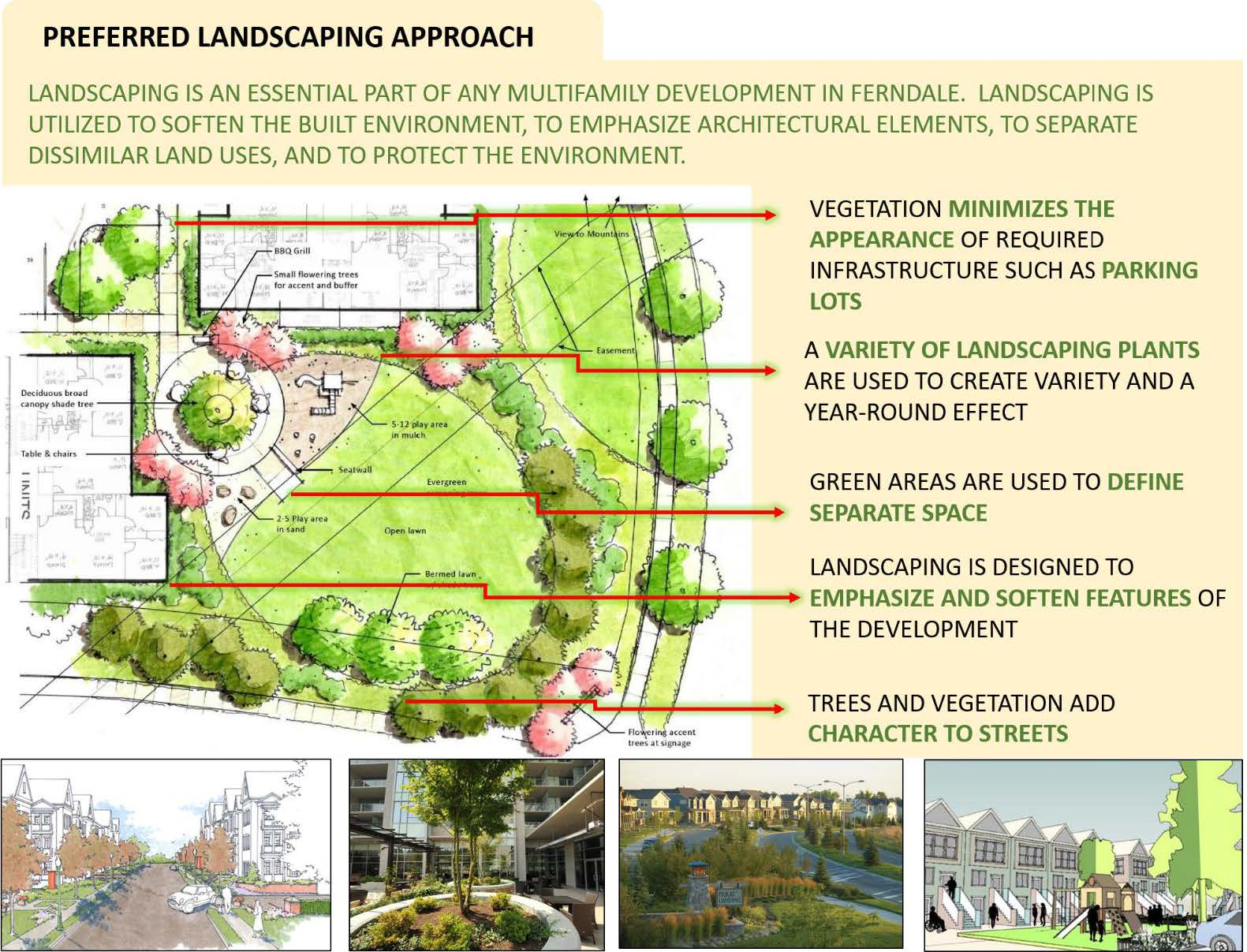
(Ord. 2026 § 1 (Exh. 1), 2017)


